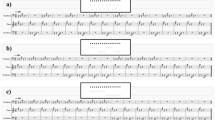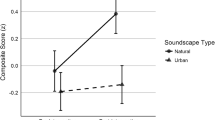Abstract
Five autistic and five normal children were allowed to register a sensory modality preference by bar pressing to select either a visual (slides) or an auditory (music) stimulus. The children were then taught a discrimination between the presence or absence of a compound auditory-visual stimulus (white noise and light). Testing for stimulus overselectivity revealed that the autistic children attended to only one aspect of the compound stimulus. In all cases this was the sensory modality that was selected during the preference test. Significant correlations were obtained between Gesell developmental scores and degree of overselectivity. Normal children registered an equal preference for music and slides and displayed no overselectivity.
Similar content being viewed by others
References
Creak, M. Schizophrenic syndrome in childhood. Further progress report of a working party.Developmental Medicine Childhood Neurology, 1964,6, 530–535.
Frankel, F., Tymchuk, A., & Simmons, J. Operant analysis and intervention with autistic children: Implications of current research. In E. Ritvo, (Ed.),Autism: Diagnosis, current research and management. New York: Spectrum, 1976.
Hale, G., & Morgan, J. Developmental trends in children's component selection.Journal of Experimental Child Psychology, 1973,15, 302–314.
Hale, G., & Taweel, S. Children's component selection with varying degrees of training.Journal of Experimental Child Psychology, 1974,17, 229–241.
Hermelin, B., & O'Connor, N.Psychological experiments with autistic children. London: Pergamon Press, 1970.
House, B., & Zeaman, D. A comparison of discrimination learning in normal and mentally defective children.Child Development, 1958,29, 411–416.
House, B., & Zeaman, D. Visual discrimination learning and intelligence in defectives of low mental age.American Journal of Mental Deficiency, 1960,65, 51–58.
Kaugman, M., & Prehm, N. A review of research on learning sets and transfer of training in mental defective. In N. Ellis (Ed.),International review of research in mental retardation (Vol. 2). New York: Academic Press, 1966.
Koegel, R.Selective attention to prompt stimuli by autistic and normal children. Unpublished doctoral dissertation, University of California at Los Angeles, 1971.
Koegel, R., & Rincover, A. Some detrimental effects of using extra stimuli to guide responding in autistic and normal children.Journal of Abnormal Child Psychology, 1976,4, 59–71.
Koegel, R., & Schreibman, L. The role of stimulus variables in teaching autistic children. In O. Lovaas & B. Butcher (Eds.),Perspectives in behavior modification with deviant children. New York: Prentice-Hall, 1974.
Koegel, R., & Schreibman, L. Teaching autistic children to respond to simultaneous multiple cues.Journal of Experimental Child Psychology, 1977,24, 299–311.
Koegel, R., & Wilhelm, H. Selective responding to the components of multiple visual cues.Journal of Experimental Child Psychology, 1973,15, 442–453.
Kovattana, P. M., & Kraemer, H. C. Response to multiple visual cues of color, size, and form by autistic children.Journal of Autism and Childhood Schizophrenia, 1974,4, 251–261.
Lovaas, O.The autistic child: Language development through behavior modification. New York: Irvington, 1977.
Lovaas, O., Koegel, R., & Schreibman, L. Stimulus overselectivity in autism: A review of research.Psychological Bulletin, 1979,86, 1236–1254.
Lovaas, O., Koegel, R., Simmons, J., & Long, J. Some generalization and follow-up measures on autistic children in behavior therapy.Journal of Applied Behavior analysis, 1973,6, 131–165.
Lovaas, O., Schreibman, L., Koegel, R., & Rehm, R. Selective responding of autistic children to multiple sensory input.Journal of Abnormal Psychology, 1971,77, 211–222.
Reese, H. Discrimination learning set in children. In L. Lipsett & C. Spiker (Eds.),Advances in child development and behavior (Vol. 1). New York: Academic Press, 1963.
Reynolds, B., Newsom, C., & Lovaas, O. Auditory overselectivity in autistic children.Journal of Abnormal Child Psychology, 1974,2, 253–263.
Rincover, A. Sensory extinction: A procedure for eliminating self-stimulatory behavior in psychotic children.Journal of Abnormal Child Psychology, 1978,6, 299–310. (a)
Rincover, A. Variables affecting stimulus fading and discriminative responding in psychotic children.Journal of Abnormal Psychology, 1978,87, 541–553. (b)
Rincover, A., Cook, R., Peoples, A., & Packard, D. Sensory extinction and sensory reinforcement principles for programming multiple adaptive behavior change.Journal of Applied Behavior analysis, 1979,12, 221–233.
Rincover, A., & Koegel, R. Setting generality and stimulus control in autistic children.Journal of Applied Behavior Analysis, 1975,8, 235–246.
Rincover, A., & Koegel, R. Research on the education of autistic children: Recent advances and future direction. In B. Lahey & A. Kazdin (Eds.),Advances in child clinical Psychology (Vol. 1). New York: Plenum Press, 1977.
Rincover, A., Newsom, C., Lovaas, O., & Koegel, R. Some motivational properties of sensory stimulation in psychotic children.Journal of Experimental Child Psychology, 1977,24, 312–323.
Ross, A.Psychological aspects of learning disabilities and reading disorders. New York: McGraw-Hill, 1976.
Schover, L., & Newsom, C. Overselectivity, developmental level, and overtraining in autistic normal children.Journal of Abnormal Child Psychology, 1976,4, 289–298.
Schreibman, L. Effects of within stimulus and extra stimulus prompting in discrimination learning in autistic children.Journal of Applied Behavior Analysis, 1975,8, 91–112.
Schreibman, L., Koegel, R., & Craig, M. Reducing stimulus overselectivity in autistic children.Journal of Abnormal Child Psychology, 1977,5, 425–436.
Schreibman, L., & Lovaas, O. Overselective response to social stimuli by autistic children.Journal of Abnormal Child Psychology, 1973,1, 152–168.
Varni, J. Lovaas, O., Koegel, R., & Everett, N. An analysis of observational learning in autistic and normal children.Journal of Abnormal Child Psychology, 1979,7, 31–43.
Wilhelm, H., & Lovaas, O. Stimulus overselectivity: A common feature in autism and mental retardation.American Journal of Mental Deficiency, 1976,81, 227–241.
Author information
Authors and Affiliations
Additional information
This research was supported in part by Public Health Service grant MH-04665 from the National Institute of Mental Health.
Rights and permissions
About this article
Cite this article
Kolko, D.J., Anderson, L. & Campbell, M. Sensory preference and overselective responding in autistic children. J Autism Dev Disord 10, 259–271 (1980). https://doi.org/10.1007/BF02408285
Issue Date:
DOI: https://doi.org/10.1007/BF02408285




